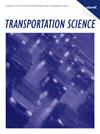Demand Steering in a Last-Mile Delivery Problem with Home and Pickup Point Delivery Options
IF 4.8
2区 工程技术
Q1 OPERATIONS RESEARCH & MANAGEMENT SCIENCE
引用次数: 0
Abstract
To increase the efficiency of last-mile delivery, online retailers can adopt pickup points in their operations. The retailer may then incentivize customers to steer them from home to pickup point delivery to reduce costs. However, it is usually uncertain whether the customer accepts this incentive to switch to pickup delivery. This setup gives rise to a new last-mile delivery problem with integrated incentive and routing decisions under uncertainty. We model this problem as a two-stage stochastic program with decision-dependent uncertainty. In the first stage, a retailer decides which customers to incentivize. However, customers’ reaction to the incentive is stochastic: they may accept the offer and switch to pickup point delivery, or they may decline the offer and stick with home delivery. In the second stage, after customers’ final delivery choices are revealed, a vehicle route is planned to serve customers via the delivery option of their choice. We develop an exact branch-and-bound algorithm and propose several heuristics to improve the algorithm’s scalability. Our algorithm solves instances with up to 50 customers, realizing on average 4%–8% lower last-mile delivery costs compared with the commonly applied approaches in the industry that do not use incentives or offer incentives to all customers. We also develop a benchmark policy that gives very fast solutions with a 2% average optimality gap for small instances and up to 2% average cost increase compared with the heuristic solutions.Funding: This project received funding from the European Union’s Horizon 2020 research and innovation program under the Marie Skłodowska-Curie grant agreement [Grant 765395].Supplemental Material: The online appendix is available at https://doi.org/10.1287/trsc.2023.0287 .最后一英里送货问题中的需求引导与送货上门和取货点送货选择
为了提高最后一英里配送的效率,在线零售商可以在其运营中采用取货点。然后,零售商可以激励客户将送货上门改为取货点送货,以降低成本。然而,顾客是否接受这种鼓励,转而使用取货点送货,通常是不确定的。在这种情况下,就产生了一个新的 "最后一英里 "配送问题,即在不确定的情况下,激励机制和路线选择决策相结合的问题。我们将这一问题建模为一个两阶段随机程序,具有决策依赖的不确定性。在第一阶段,零售商决定激励哪些客户。然而,顾客对激励措施的反应是随机的:他们可能会接受激励措施并转向自提点送货,也可能会拒绝激励措施并坚持送货上门。在第二阶段,当客户的最终送货选择揭晓后,我们会规划一条车辆路线,通过客户选择的送货方式为其提供服务。我们开发了一种精确的分支与边界算法,并提出了几种启发式方法来提高算法的可扩展性。我们的算法可以解决多达 50 个客户的实例,与业内普遍采用的不使用激励措施或向所有客户提供激励措施的方法相比,最后一英里配送成本平均降低了 4%-8%。我们还开发了一种基准策略,它能提供非常快速的解决方案,与启发式解决方案相比,小实例的平均优化差距为 2%,平均成本增加最多为 2%:本项目得到了欧盟 "地平线 2020 "研究与创新计划玛丽-斯克沃多夫斯卡-居里基金协议[Grant 765395]的资助:在线附录见 https://doi.org/10.1287/trsc.2023.0287 。
本文章由计算机程序翻译,如有差异,请以英文原文为准。
求助全文
约1分钟内获得全文
求助全文
来源期刊

Transportation Science
工程技术-运筹学与管理科学
CiteScore
8.30
自引率
10.90%
发文量
111
审稿时长
12 months
期刊介绍:
Transportation Science, published quarterly by INFORMS, is the flagship journal of the Transportation Science and Logistics Society of INFORMS. As the foremost scientific journal in the cross-disciplinary operational research field of transportation analysis, Transportation Science publishes high-quality original contributions and surveys on phenomena associated with all modes of transportation, present and prospective, including mainly all levels of planning, design, economic, operational, and social aspects. Transportation Science focuses primarily on fundamental theories, coupled with observational and experimental studies of transportation and logistics phenomena and processes, mathematical models, advanced methodologies and novel applications in transportation and logistics systems analysis, planning and design. The journal covers a broad range of topics that include vehicular and human traffic flow theories, models and their application to traffic operations and management, strategic, tactical, and operational planning of transportation and logistics systems; performance analysis methods and system design and optimization; theories and analysis methods for network and spatial activity interaction, equilibrium and dynamics; economics of transportation system supply and evaluation; methodologies for analysis of transportation user behavior and the demand for transportation and logistics services.
Transportation Science is international in scope, with editors from nations around the globe. The editorial board reflects the diverse interdisciplinary interests of the transportation science and logistics community, with members that hold primary affiliations in engineering (civil, industrial, and aeronautical), physics, economics, applied mathematics, and business.
 求助内容:
求助内容: 应助结果提醒方式:
应助结果提醒方式:


